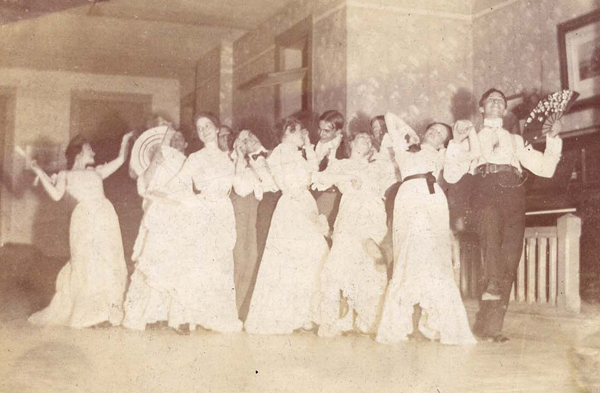Social life was an important component of the college experience in Indiana at the turn of the last century. This photograph was taken at a dance at Kappa Sigma fraternity during Pan-Hel week on the Wabash College campus in 1900.
In the year 1900, Winthrop Stone assumed the presidency of Indiana’s land-grant school, Purdue University. Like other educational reformers of the time, he believed that college represented the place where young men developed their adult character as well as learned their profession. Stone was also determined to train the best young Hoosiers to be engineers and scientific-minded farmers. He supported as well the progressive vision that women should be accepted into the academic programs of the school.
Unfortunately, Stone brought to Indiana what was later remembered as an “austere personality” similar to fellow-New-Hampshire-born Calvin Coolidge. Stone accepted personal responsibility for reforming not only the academics of the school but also the moral character and lifestyle of its students. It was here that the president met with his greatest challenges. The culture of male college students at Purdue, as at other schools across the country, was built not only on scholarship but on athletics, fraternities and other clubs, and boisterous drinking and partying.
Stone lectured students at mandatory chapel services and assemblies. Students who committed particularly egregious assaults upon the rules of campus were summoned to his office for a personal dressing down. When hectoring failed, Stone tried to shame the students into good behavior, declaring in one speech that the good citizens of Lafayette now assumed that any young man seen on their streets publicly intoxicated was a student at Purdue.
Stone’s moralizing met with little success. The school’s Association of Dorm Devils existed to haze and harass new undergraduates; freshmen might expect to be stripped down and shaved top to bottom or forced to parade through campus in their nightshirts. Stone took over the dormitory over which they ruled and turned it into a classroom building; in response, the students took their revels to other buildings on and off campus.
One of the most popular stunts on campus was the “Tank Scrap” in which groups of students competed to see which class could paint its class year on the city’s water tank the morning of the first football game of each year. After scraps turned into violent altercations at the foot of the water tower, Stone finally banned the practice in 1908, having been unable to control events in any other way.
Probably despite Stone’s efforts at moral reform, student culture did change at Purdue and nationwide at other college campuses. With increasing numbers of women students, dances and more sedate parties became increasingly popular pastimes. In addition, by the 1920s male students began to copy the more sophisticated culture of the period. Purdue students also became involved in campus culture in a new way, as they worked to plan and build a Student Union that opened in 1924 and quickly became the social center of the campus.
Source: “The Law of College Customs is Inexorable as the Laws of Chemistry or Physics: The Transition to a Modern Purdue University, 1900-1924,” by Ryan Anderson, Indiana Magazine of History June 2003
A Moment of Indiana History is a production of WFIU Public Radio in partnership with the Indiana Public Broadcasting Stations. Research support comes from Indiana Magazine of History published by the Indiana University Department of History.






















